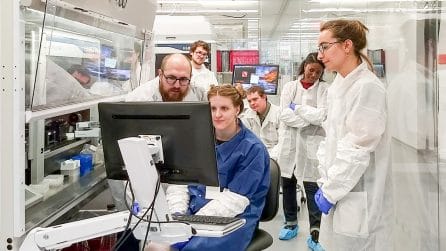Toward Better Treatments for PTSD: Lessons Learned From The First-Ever Stem Cell Model of the Disorder
NewsThe Context: Post-traumatic stress disorder (PTSD) affects more than 12 million people worldwide. Only a minority of people exposed to trauma will end up with PTSD, and scientists still do not understand why this is, or how to effectively treat it. Most cellular studies of PTSD have been conducted on blood samples, but as the brain is the primarily affected organ, it is critical to examine brain cells to understand what’s going wrong and develop better therapies.
The Study: Leveraging NYSCF’s unique automation technology, researchers created neurons from the stem cells of a large group of PTSD-affected and non-affected combat veterans and exposed them to synthetic hormones mimicking the body’s stress response, illuminating new features of PTSD-prone neurons. This study, which appears today in Nature Neuroscience, was led by Rachel Yehuda, PhD, of the Icahn School of Medicine at Mount Sinai and Office of Veterans Affairs in collaboration with NYSCF – Robertson Stem Cell Investigator Alumna Kristen Brennand, PhD, of Yale School of Medicine, and NYSCF’s Daniel Paull, PhD.
The Importance: This study is the first to create a stem cell model of PTSD, showing unique features of hypersensitive PTSD-prone neurons to stress. This lays the groundwork for understanding why certain people are more prone to develop this disorder, and for discovering new treatments.
Post-traumatic stress disorder can develop following severe trauma and is an enormous public health problem for both veterans and civilians. One of the trickiest aspects of PTSD is that it is hard to predict who will get it and why.
“Two people can experience the same trauma, but they won’t necessarily both develop PTSD,” explained Dr. Brennand. “We set out to explore how genetics can make someone more susceptible to PTSD, and what exactly is going on in their brains to make this happen.”
Stem Cells Recreate the Brain of a PTSD Patient
“Rachel [Yehuda] has been doing this amazing clinical study where she follows combat veterans, and we thought this could be a perfect group from which to create stem cells,” said Dr. Brennand.
Importantly, most studies of PTSD have been conducted by looking at the blood of patients, but PTSD is a disorder of the brain. To truly understand what causes it and how to best treat it, we need to take a closer look at how it affects neurons.

“Brain cells are pretty inaccessible – it’s not like we can go around taking chunks out of people’s brains,” said Dr. Paull. “Stem cells allow us to create brain cells from just a small sample of skin or blood, allowing a unique window into the brain.”
“Reprogramming cells into induced pluripotent stem cells is like virtually taking cells back in time to when they were embryonic and had the ability to generate all the cells of the body,” said Dr. Yehuda. “These cells can then be differentiated into neurons with the same properties as that person’s brain cells had before trauma occurred to change the way they function. The gene expression networks from these neurons reflect early gene activity resulting from genetic and very early developmental contributions, so they are a reflection of the ‘pre-combat’ or ‘pre-trauma’ gene expression state.”
NYSCF scientists used their revolutionary robotic platform – The NYSCF Global Stem Cell Array® – to create stem cells from 39 combat veterans: 19 with PTSD and 20 without. They then turned these stem cells into neurons and exposed them to different levels of hydrocortisone – a stress hormone – to mimic the cellular environment of PTSD.
“So we’ve got these cells in a dish with all the genetic risk factors that we think contribute to PTSD,” said Dr. Brennand. “We can then expose them to a synthetic stress hormone and ask questions about how genetics influence the cells’ response.”

Dr. Paull also stressed the importance of automation for an experiment like this, which allowed NYSCF’s scientists to generate neurons from multiple individuals with remarkable uniformity in terms of identity and cell number.
“To do a study of this scale, automation is essential,” said Dr Paull. “With the Array, we can make standardized cells that allow for meaningful comparisons between individuals, pointing to key differences that could be critical for discovering new treatment opportunities.”
Stressed PTSD Cells Reveal Their Unique Features
“The addition of stress hormones to these cells simulates biological effects of combat, which allows us to determine how different gene networks mobilize in response to stress exposure in brain cells,” explained Dr. Yehuda.
“We found that when exposed to low doses of the stress hormone hydrocortisone, neurons from people with PTSD were hypersensitive,” noted Dr. Brennand.
Additionally, the stressed PTSD-prone cells revealed a particularly active set of genes, which had been previously associated with PTSD and neurodevelopmental disorders.
“We also discovered a PTSD-specific gene signature in cells exposed to stressors, and importantly, this matched a signature present in post mortem brain tissue of individuals with PTSD,” noted NYSCF Principal Scientist Tom Rusielewicz, PhD.

“[That] tells us that stem cell models are providing a pretty accurate reflection of what happens in patient brains,” noted Dr. Paull.
Remarkably, the authors were only able to identify a PTSD-specific gene signature when they treated the neurons with hydrocortisone – not prior to administering the stressor – indicating that differences between PTSD patients and controls only manifested when stressing the cells.
“We successfully recreated PTSD in a dish with an environmental stimulus, and only with an environmental stimulus,” highlighted Dr. Rusielewicz.
The work also points to new opportunities for better therapies.
“What’s really exciting about our findings is the opportunities they offer for accelerating the diagnosis and treatment of PTSD,” Dr. Paull added. “Importantly, having a robust stem cell model provides an ideal avenue to drug screening ‘in the dish,’ even across diverse patient populations.”
What’s Next?

“We next want to study more cell types,” said Dr. Brennand. “We’re also working on coming up with a list of already-approved drugs that we suspect could perhaps reverse the hypersensitivity we’re seeing in neurons.”
“Another question I think is really interesting is why are patient neurons hyperresponsive? And are they all hyperresponsive for the same reasons? Once we understand this, we can start moving towards personalized medicine, and we’ll need further experiments to interrogate those questions,” she added.
A Study Fueled By Team Science
Importantly, the scientists emphasized that this study would not have been possible without collaboration between several talented teams.
“Everybody brought something different,” said Dr. Rusielewicz. “We wouldn’t have been able to do this on our own. Rachel Yehuda is an expert in PTSD and epigenetics, and Kristen Brennand helped apply this work to stem cells. We helped scale it up with our automation technology. Many people were instrumental in making this study possible.”
“What’s exciting about this study is that it could have only been done by this group,” agreed Dr. Brennand. “It involved some of the best clinicians in this space, incredible stem cell biologists, and amazing psychiatric geneticists. Each group has unique expertise, and none of this could have been accomplished by any one team alone.”
“This study is a true testament to the power of team science,” added Dr. Paull. “When researchers combine forces, we are able to ask bigger questions, make bigger discoveries, and hopefully, make a bigger difference for patients.”
Cover image: neurons derived from the stem cells of PTSD patients
Journal Article:
Modeling gene × environment interactions in PTSD using human neurons reveals diagnosis-specific glucocorticoid-induced gene expression
Carina Seah, Michael S. Breen, Tom Rusielewicz, Heather N. Bader, Changxin Xu, Christopher J. Hunter, Barry McCarthy, PJ Michael Deans, Mitali Chattopadhyay, Frank Desarnaud, Iouri Makotkine, Janine D. Flory, Linda M. Bierer, Migle Staniskyte, NYSCF Global Array Team, Scott A. Noggle, Laura M. Huckins, Daniel Paull, Kristen J. Brennand, Rachel Yehuda. Nature Neuroscience. 2022. DOI: https://www.nature.com/articles/s41593-022-01161-y

